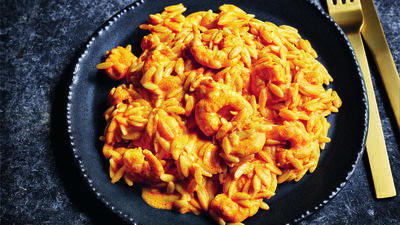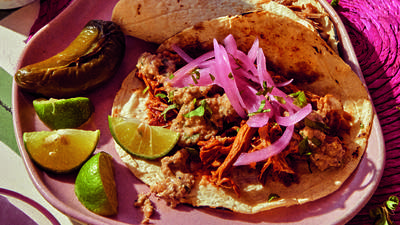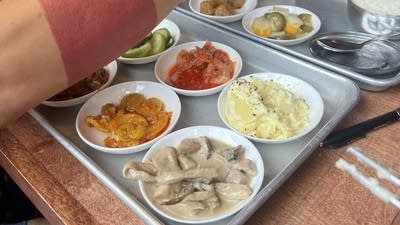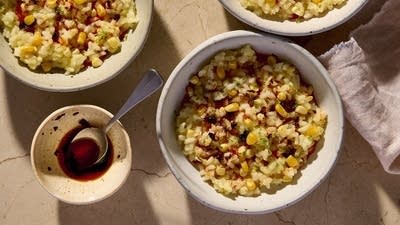
The next gem we’re going to see on cheffy food trucks and in fusion places is bao. Bao is little Asian steamed buns stuffed with all kinds of things. Now bao is already hitting the coasts, and we are going to love every bite as it sweeps the country.
Eddie Huang is one of the masters of bao and the author of Fresh Off the Boat: A Memoir. He makes his living making bao at BaoHaus, his restaurant in New York.
Lynne Rossetto Kasper: You do these things called bao. I’ve seen different things called by that same name. What makes bao?
Eddie Huang: Bao just means bun or bread in Chinese and Vietnamese. At the very core of bao is Asian sugar dough. So whether you’re in East Asia or Southeast Asia, it’s white steamed Asian sugar dough. It comes from China, but it’s taken on various forms, shapes and utilizations in many parts of East and Southeast Asia.
LRK: But the bao I’ve been seeing is one that looks like a stuffed bun. One side is open. It’s almost like a little hamburger roll that wasn’t cut all the way through.
EH: That is a gua bao. That shape where the bun looks like a taco-slider hybrid comes from Taiwan.
LRK: That’s where your family’s from, right?

EH: Yes. My father and my mother were both born in Taiwan, and the gua bao is traditionally filled with braised pork belly. You add pickled mustard greens, cilantro, peanuts and Taiwanese red sugar, and that is the quintessential Taiwanese sandwich.
LRK: Are there traditional fillings for each kind of bao -- the ones that you stuff like a dumpling and other forms of it?
EH: At the base level of bao is manto, which is just a big block of steamed Asian sugar dough. Most of the time, it’s formed in a block or it’ll be twirled. That's kind of our equivalent to the bagel.
When describing Asian food, I like to draw parallels to Jewish food because there are so many similarities. My grandfather used to sell those in Taiwan and in China. So my family, 50 to 60 years ago, they were making the bagel and now we’re doing the slider -- the Taiwanese version.
LRK: How was this twist eaten? Was it dipped in a sauce? Did it have something on top? Or was it just the bread?
EH: It’s very proletariat food because it is just bread. But you always eat bao with hot soy milk or mi jung, which is a rice and peanut drink. When it’s cold in the morning in Beijing, or wherever you are you wake up in the morning, you drink a soy milk and you have a manto.
LRK: Now we’ve got the round steamed buns that you find in the dim sum places. What are the traditional fillings there?
EH: The traditional filling in an enclosed bao (which looks like a dumpling with a knot on the top) would be cha siu bao, and that is the red caramelized roasted pork that’s inside. You’ll also at times have pork and Chinese chives, yellow chives, and then you’ll also have a siu bao which is yellow Chinese chives, some egg, some mung bean noodles and such. It’s a vegetarian version.
With the manto, which is the bagel form, they‘ll also sometimes cut it open or stuff it with dried pork sung, which is a very, very popular topping that we use on any sort of bread. We’ll put it in rice balls. Dried pork sung is the proletarian protein jerky of choice in East Asia. It’s a dried pork jerky that’s kind of shredded. Sometimes you’ll see the translation as pork floss or pork sung. The brand that I like is Formosa brand from Taiwan.
LRK: What does it taste like?

EH: One thing I always find interesting about Asian food is that we like to do things that I call sweet meat, meaning we always have a little more sugar in our savory dishes than maybe American food does, until you go to the South. In the South, they really understand this concept of sweet meat as well.
Pork floss has this savory umami and the essence of pork, and it has the base notes from the animal protein. It has a little soy component to it as well, and it’s kind of sweet and savory and just a great jerky topping.
LRK: As far as making this bun now, is there a particular technique? It’s a steamed bread, right? Is it sort of a straight white yeast bread with sugar added?
EH: It’s very much like Wonder Bread in a lot of ways. If you Google and find an Asian sugar dough recipe and a Wonder Bread recipe, they’re very, very similar.
LRK: That’s what it always reminds me of, except the fillings are just amazing. And that seems to be the big deal now: Everybody’s doing these cross-cultural or inventive fillings. Are you into that as well?
EH: I’ll be honest, I’m really not too into the cross-cultural fillings. We’ve done a few and people liked it. But at the end of the day, after running those specials for a year with different flavors, I said, "You know what? Why give people options that I wouldn’t want to eat on a daily basis?" I started to limit the options at the restaurant because I want people to eat it in what I feel is the best form -- which is that pork belly.
I love a Taiwanese chicken chop inside of it. I really like to keep a Taiwanese flavor profile with my baos. Also, that Asian sugar dough is so unique. It has a very, very particular flavor especially because we steam ours in lotus leaves.
If you buy these baos at the Chinese grocery store -- it’s totally fine to buy them frozen, the quality is not affected -- try to steam them in lotus leaves. The lotus leaves will give it flavor and a little interesting color too. It kind of has a nose to it like rosewater or jasmine.
LRK: And you can usually find those at Asian markets?
EH: Absolutely. It’s not an Asian market if it doesn’t have lotus leaves. The lotus leaves come dry and you want to steep them. It’s a very simple steeping process. The baos usually come frozen, and I’m telling you, that’s how most people are making them.
The sugar dough is so simple. It’s almost as if you went to a Texas barbecue place or Arthur Bryant’s and you’re like, "Did you make your own white bread?" You really don’t; it’s kind of fine as is.
Before you go...
Each week, The Splendid Table brings you stories that expand your world view, inspire you to try something new, and show how food connects us all. We rely on your generous support. For as little as $5 a month, you can have a lasting impact on The Splendid Table. And, when you donate, you’ll join a community of like-minded individuals who love good food, good conversation, and kitchen companionship. Show your love for The Splendid Table with a gift today.
Thank you for your support.
Donate today for as little as $5.00 a month. Your gift only takes a few minutes and has a lasting impact on The Splendid Table and you'll be welcomed into The Splendid Table Co-op.




